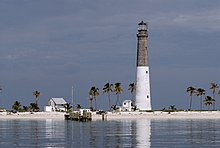Dry Tortugas Light

The Dry Tortugas Light is on Loggerhead Key
|
|
|
Florida
|
|
| Location | Loggerhead Key Dry Tortugas Florida United States |
|---|---|
| Coordinates | 24°38′0.1″N 82°55′14.0″W / 24.633361°N 82.920556°WCoordinates: 24°38′0.1″N 82°55′14.0″W / 24.633361°N 82.920556°W |
| Year first constructed | 1858 |
| Automated | 1988 |
| Foundation | stone basement |
| Construction | brick tower |
| Tower shape | tapered cylindrical tower with balcony and lantern |
| Markings / pattern | white lower half tower, natural gray upper half tower, black lantern |
| Height | 157 feet (48 m) |
| Focal height | 151 feet (46 m) |
| Original lens | 1st Fresnel lens Later, 2nd order |
| Current lens | VRB-25 aerobeacon |
| Light source | solar power |
| Range | 20 nautical miles (37 km; 23 mi) |
| Characteristic | Fl W 20s. |
| Racon | "K" (−∘−) |
| Admiralty number | J3060 |
| ARLHS number | USA-236 |
| USCG number | 3-1095 |
The Dry Tortugas Light is located on Loggerhead Key, three miles west of Fort Jefferson, Florida.
In 1856, Capt. Daniel Phineas Woodbury supervised construction of the lighthouse, based on an 1855 design by Capt. Horatio Wright, and became operational in 1858.
The Loggerhead Key lighthouse has a stone foundation and a conical brick tower. The walls are 6 feet (1.8 m) thick at the base and taper to 4 feet (1.2 m) thick at the top. The tower was painted black on the upper part and white below (later unpainted on the upper part and white below). A radio room is attached to the base of the tower. The original lens was a first order Fresnel lens, which is now on display at the United States Coast Guard Aids to Navigation School in Yorktown, Virginia. The light was automated in 1988.
The first lighthouse in the Dry Tortugas was on Garden Key, and became operational in 1826. After several proposals for a new lighthouse on the "outer shoals" of the Dry Tortugas, a new lighthouse was built on Loggerhead Key and completed in 1858 at a cost of US$35,000, which was the amount that had been projected to upgrade the existing lighthouse on Garden Key.
The Dry Tortugas lighthouse, along with the Garden Key lighthouse at Fort Jefferson, were the only lights on the Gulf coast that stayed in full operation throughout the American Civil War. A civilian prisoner of Fort Jefferson, John W. Adare and a companion, used planks to swim to the Key and stole the keeper's boat. Although they made it to Havana, the Spanish authorities there extradited them back to Key West. Undeterred, Adare attempted a second escape, one in which he needed a second plank for his ankle ball and chain. This time the boat was locked and Adare was captured the next day.
...
Wikipedia

